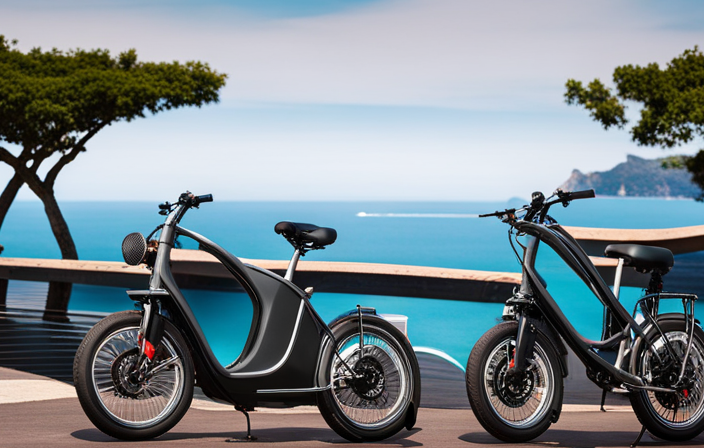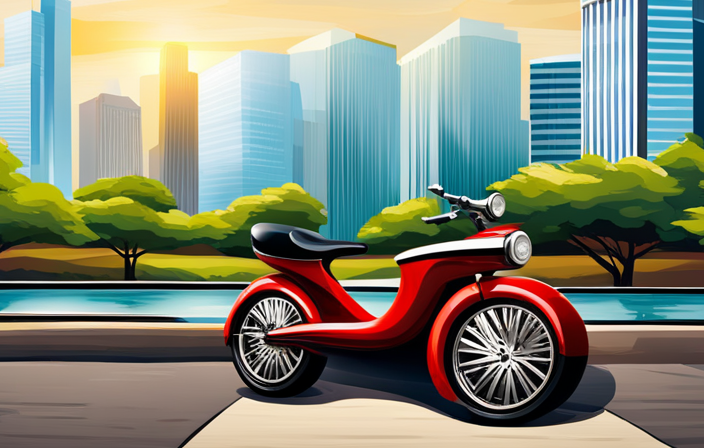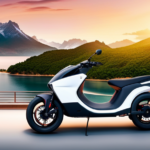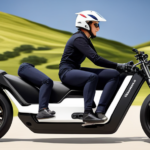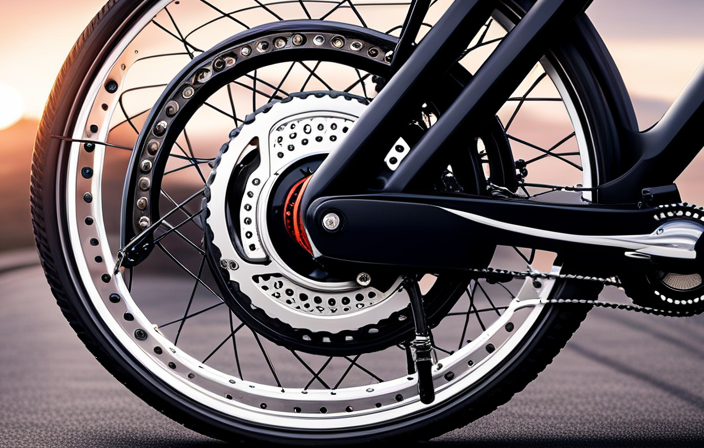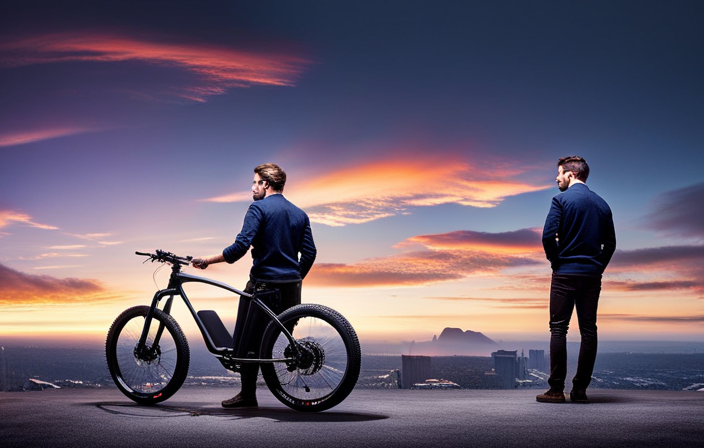Ever thought about the distance an electric bike can go?
Strap on your helmet and join me on a journey to unveil the secrets behind the mileage of these eco-friendly wonders.
From battery capacity and motor power to rider weight and terrain, we’ll explore the factors that determine the distance an electric bike can cover.
With real-life examples and testimonials, this article will arm you with the knowledge you need to make the most of your electric bike adventures.
Let’s dive in!
Key Takeaways
- The performance of an electric bike is affected by factors such as temperature, wind, rain, and bike weight, which can all impact the range and battery life.
- Aerodynamic features, such as a streamlined frame design, narrow handlebars, fairings, and aerodynamic wheels, can improve the mileage of an electric bike by reducing wind resistance and drag.
- Regular maintenance and care, including cleaning the bike, checking tire pressure, monitoring battery charge level, and getting professional servicing, is important for optimal performance and longevity of an electric bike.
- Range extenders and additional batteries can be used to increase the mileage of an electric bike, providing extra range for longer rides or when an extra boost is needed. Proper battery charging techniques should be followed to maximize lifespan and performance.
Battery Capacity and Type
An electric bike’s battery capacity and type determine how many miles it can last. The battery life of an electric bike refers to how long the battery can power the bike before it needs to be recharged. This is an important factor to consider when purchasing an electric bike, as it directly impacts the distance you can travel on a single charge.
Different electric bikes have different battery capacities, typically measured in watt-hours (Wh). A higher battery capacity means a longer battery life and, therefore, more miles you can ride. Additionally, the type of battery used in the electric bike also affects its performance. Lithium-ion batteries are commonly used due to their high energy density and longer lifespan.
Charging time is another crucial aspect to consider. It is the time required to fully charge the battery from empty to full. This varies depending on the battery capacity and the charger used.
Now, let’s move on to the next section about motor power and efficiency.
Motor Power and Efficiency
When it comes to electric bikes, understanding the motor power and efficiency is crucial. Exploring different motor types allows us to see the range of options available and how they impact performance.
Additionally, understanding how motor power affects range is important in determining how far you can go on a single charge. By delving into these key points, we can make informed decisions when choosing an electric bike that fits our needs and preferences.
Exploring different motor types
There’s a wide range of electric bike motor types to choose from. When selecting an electric bike, it’s important to consider the different options available and how they can affect the performance of your ride. To help you make an informed decision, let’s take a closer look at some popular bike motor types and their characteristics.
| Motor Type | Description |
|---|---|
| Hub Motors | These motors are located in the hub of the wheel and provide direct drive. They are known for their simplicity and durability. |
| Mid-drive Motors | These motors are positioned near the cranks and provide power directly to the drivetrain. They offer better weight distribution and improved handling. |
| Friction Drive Motors | These motors use friction to drive the wheel and are easy to install and remove. They are lightweight and provide a natural riding experience. |
| All-in-One Motors | These motors combine the motor, battery, and controller into one unit. They are compact and suitable for smaller bikes. |
Understanding bike motor types and their performance analysis is crucial in determining the right motor for your electric bike. Now, let’s dive into how motor power affects the range of an electric bike.
How motor power affects range
To understand how motor power affects the range of your electric bike, consider the relationship between the two.
Motor power and speed go hand in hand. A more powerful motor will allow you to reach higher speeds, which can have an impact on your bike’s range. When you ride at higher speeds, the motor has to work harder, draining the battery faster and reducing the overall range.
On the other hand, motor power and acceleration are also interconnected. A powerful motor can provide quick and smooth acceleration, but it may consume more energy in the process. Therefore, finding the right balance between motor power and speed is crucial to maximize the range of your electric bike.
Moving on to the next section, let’s explore how terrain and elevation affect the range.
Terrain and Elevation
The mileage of an electric bike can be affected by the terrain and elevation. When riding through steep slopes, the motor has to work harder to maintain the same speed, which can significantly reduce the range of the bike. Additionally, rough terrain can also impact the battery efficiency. Constant vibrations and bumps can cause the battery to drain faster, decreasing the overall mileage.
To further illustrate the effects of terrain and elevation on an electric bike’s range, consider the following:
-
Steep slopes: Climbing uphill requires more power from the motor, resulting in increased energy consumption and reduced mileage.
-
Rough terrain: Riding on bumpy surfaces or uneven roads can lead to higher energy expenditure due to the constant need for motor assistance, ultimately decreasing the bike’s range.
-
Elevation changes: Going up and down hills can have a significant impact on the bike’s mileage, as the motor has to adjust power output accordingly.
Understanding how terrain and elevation affect the range of an electric bike is crucial for optimizing its performance.
Moving forward, let’s explore how rider weight and pedal assistance level can further influence the mileage.
Rider Weight and Pedal Assistance Level
Rider weight and pedal assistance level have a direct impact on the overall performance and range of an electric bike. The weight of the rider affects the power consumption of the motor, as it has to work harder to propel a heavier load. Additionally, the pedal assistance level chosen by the rider determines how much effort is required from the motor.
To illustrate this, consider the following table:
| Rider Weight (lbs) | Pedal Assistance Level | Range (miles) |
|---|---|---|
| 150 | Low | 40 |
| 200 | Medium | 30 |
| 250 | High | 20 |
| 300 | Turbo | 15 |
| 350 | Turbo | 10 |
It is important to note that rider fitness level also plays a role in the range of an electric bike. A more fit rider may be able to rely less on the motor, thus conserving battery power. Additionally, the battery charging time should be taken into consideration when planning longer rides.
Considering rider weight and pedal assistance level, the next section will explore the impact of riding style and speed on the range of an electric bike.
Riding Style and Speed
Riding style and speed greatly affect the range of an e-bike. Your riding technique plays a significant role in determining how far your electric bike can go on a single charge. For example, if you ride aggressively, constantly accelerating and decelerating, you will drain the battery much faster compared to riding in a more controlled manner.
Additionally, frequent stops and starts, such as at traffic lights or intersections, can also have a negative impact on the overall range of your e-bike. Therefore, it is important to be mindful of your riding style and try to maintain a consistent speed whenever possible to maximize the mileage.
Transitioning into the next section about weather conditions, it’s worth noting that the impact of riding style and speed on range can be further compounded by external factors such as wind resistance or incline.
Weather Conditions
When it comes to electric bikes, weather conditions can have a significant impact on their performance and range.
Riding in extreme heat or cold can affect battery life and overall performance, as temperature extremes can negatively impact the efficiency of the battery.
Additionally, wind and rain can also affect the range of an electric bike, as the resistance caused by strong winds or the added weight of water can decrease the overall efficiency.
Therefore, it is important to consider these factors when planning your rides and to take appropriate precautions to ensure optimal performance in different weather conditions.
Riding in extreme heat or cold
In extreme heat or cold, the mileage of an electric bike may be affected. Riding in extreme temperatures can have a significant impact on battery performance and temperature, ultimately affecting the range of the electric bike. Here are three key factors to consider when riding in extreme heat or cold:
-
Temperature: Extreme temperatures can cause the battery to heat up or cool down, affecting its overall performance. High temperatures can accelerate battery degradation, reducing its capacity and range. On the other hand, extremely cold temperatures can cause the battery to temporarily lose some of its power.
-
Insulation: Proper insulation is crucial when riding in extreme temperatures. Insulating the battery and other sensitive components can help maintain optimal performance and prevent any adverse effects caused by extreme heat or cold.
-
Precautionary measures: To optimize the range in extreme temperatures, it is advisable to take certain measures. These include storing the battery in a cool place before the ride, keeping it away from direct sunlight, and avoiding exposing the bike to extreme temperatures for extended periods.
Considering the impact of weather conditions on electric bike range, the next section will discuss the influence of wind and rain on the overall mileage.
The impact of wind and rain on range
The impact of wind and rain on range can vary depending on the specific weather conditions and the bike’s design. When riding in windy conditions, the resistance caused by the wind can significantly reduce the range of an electric bike. Strong headwinds require more power to overcome, resulting in shorter battery life. Similarly, riding in heavy rain can also affect the range of an electric bike. Wet roads can increase rolling resistance, making it harder for the bike to maintain speed and efficiency. Additionally, rain can also damage the electrical components of the bike if not properly protected. Therefore, it is important to consider the impact of temperature, road surface, and weather conditions when estimating the range of an electric bike. Taking these factors into account will help you plan your rides more effectively. Moving on to the next section about bike weight and aerodynamics, these factors also play a crucial role in determining the range of an electric bike.
Bike Weight and Aerodynamics
When it comes to electric bikes, the weight of the bike can have a significant impact on battery usage. The heavier the bike, the more energy it takes to move it forward, resulting in decreased mileage.
Additionally, considering the aerodynamics of the bike can also improve mileage. By reducing wind resistance, the bike can glide through the air more efficiently, ultimately increasing the distance it can travel on a single charge.
The effect of bike weight on battery usage
One factor that affects battery usage in electric bikes is the weight of the bike. The bike frame plays a crucial role in determining the overall weight of the electric bike. A heavier bike frame requires more power to move and maintain speed, resulting in increased power consumption. This means that the battery will drain quicker, reducing the overall mileage of the electric bike.
To optimize battery usage, manufacturers are now using lightweight materials like aluminum or carbon fiber for the bike frame, which helps to reduce the overall weight of the bike. This, in turn, improves the mileage of the electric bike.
Moving on to the next section about how aerodynamics can improve mileage, it is important to note that reducing bike weight is just one aspect of maximizing the distance an electric bike can travel.
How aerodynamics can improve mileage
Using aerodynamic design techniques can enhance the efficiency of an electric bicycle’s battery usage. By reducing drag, electric bikes can travel longer distances on a single charge. Here are four ways aerodynamics can improve mileage:
- Streamlined frame: A sleek, aerodynamic frame design reduces wind resistance, allowing the bike to slice through the air more efficiently.
- Tapered handlebars: Narrower handlebars minimize the frontal area, reducing drag and improving overall efficiency.
- Integrated fairings: Adding fairings to cover important components like the battery and motor reduces turbulence and further decreases drag.
- Aerodynamic wheels: Using wheels with streamlined profiles can significantly reduce drag, increasing the bike’s range.
By implementing these aerodynamic features, electric bikes can maximize their battery life, allowing riders to go further without needing to recharge.
With improved efficiency and reduced drag, maintenance and care for electric bikes become even more crucial to ensure optimal performance.
Maintenance and Care
To make sure your electric bike lasts for as many miles as possible, it’s important to regularly maintain and care for it. Proper maintenance is key to keeping your bike in top condition and avoiding common issues that can arise.
Firstly, regularly clean your bike, paying attention to the chain, brakes, and battery contacts. This will prevent dirt and grime from affecting performance.
Additionally, check tire pressure regularly and ensure they are properly inflated to improve efficiency. It’s also important to keep an eye on the battery’s charge level and recharge it before it goes completely empty.
Lastly, consider getting your bike serviced by a professional every few months to address any potential issues before they become major problems.
By following these maintenance tips, you can ensure your electric bike stays in great shape for many miles to come.
Speaking of range extenders and additional batteries, they are great options to consider for increasing your bike’s range without the need for step.
Range Extenders and Additional Batteries
Now that we’ve discussed the importance of maintenance and care for your electric bike, let’s delve into the topic of range extenders and additional batteries.
These options can significantly increase the mileage of your electric bike and provide you with a longer riding experience. Range extenders are devices that can be attached to your bike and work alongside the existing battery to extend its range. They can be particularly useful for longer rides or when you need that extra boost.
Additionally, knowing the right battery charging techniques is crucial for maximizing the lifespan and performance of your electric bike. Properly charging your battery can help maintain its capacity and ensure it lasts for as long as possible.
By understanding range extender options and implementing effective battery charging techniques, you can enhance the overall mileage of your electric bike.
Now, let’s move on to real-life examples and testimonials.
Real-Life Examples and Testimonials
As an electric bike owner, I’ve come across countless stories from other owners about their experiences and the mileage they’ve achieved.
It’s fascinating to compare the mileage experiences across different models and brands. Some owners have reported being able to travel up to 50 miles on a single charge, while others have found their bikes can only go half that distance.
Stories from electric bike owners
Have you ever wondered how many miles an electric bike can last? Well, let me tell you, according to stories from electric bike owners, they can go quite the distance! Here are some fascinating examples of electric bike performance:
-
John, the proud owner of a popular electric bike brand, claims that his bike can travel up to 70 miles on a single charge. He commutes to work every day without needing to recharge until he gets back home.
-
Susan, who owns a different model, reports that her electric bike can last around 50 miles before needing to be charged again. She enjoys long weekend rides through scenic trails without worrying about running out of battery.
-
Mark, an avid cyclist, opted for a high-performance electric bike. He boasts that his bike can go up to 100 miles on a single charge, allowing him to tackle challenging terrains and go on extended biking adventures.
Comparing mileage experiences across different models and brands, it is clear that electric bikes offer a range of options to suit various needs and preferences.
Comparing mileage experiences across different models and brands
If you’re curious about the range of options available for different models and brands, comparing mileage experiences across electric bikes can give you a better idea of what suits your needs.
When it comes to electric bike mileage, there are a few factors to consider.
First, the price range of electric bikes can vary significantly, and this can have an impact on the mileage you can expect. Generally, higher-end models tend to have better battery technology and can offer a longer range.
Second, the age of the battery can also affect the mileage. As the battery gets older, its capacity to hold a charge diminishes, which can result in a shorter range.
It’s important to keep this in mind when comparing mileage experiences across different electric bike models and brands.
Frequently Asked Questions
Can I use an electric bike in hilly areas with steep inclines?
Yes, you can use an electric bike in hilly areas with steep inclines. Electric bike motors have sufficient power to tackle steep terrains, and battery life expectancy allows for long rides.
How often should I charge the battery of my electric bike?
I charge my electric bike’s battery every 2-3 days to maintain its lifespan. It’s important to find the right balance between frequent charging and not overcharging. Regular charging ensures optimal performance and extends the battery’s overall lifespan.
Can I ride an electric bike in the rain or during wet weather conditions?
Yes, you can ride an electric bike in the rain or during wet weather conditions. However, it’s important to take extra maintenance precautions to ensure the longevity of your electric bike in these conditions.
Are electric bikes suitable for long-distance commuting?
Electric bikes have a great electric bike range, making them suitable for long-distance commuting. They offer the advantages of convenience, eco-friendliness, and the ability to easily navigate through traffic, ensuring a comfortable and efficient ride.
How much does it cost to replace the battery of an electric bike?
Replacing the battery of an electric bike can cost anywhere from $200 to $800, depending on the brand and model. On average, the lifespan of electric bike batteries is around 3-5 years, but it can vary based on usage and maintenance.
Conclusion
In conclusion, the mileage of an electric bike depends on various factors. These include battery capacity, motor power, terrain, and rider weight. These elements work together to determine the distance an electric bike can travel.
By understanding and optimizing these factors, you can unlock the true potential of your electric steed. This will allow you to embark on exhilarating adventures.
So, strap on your helmet, hop on your bike, and let the possibilities unfold. Ride into the sunset, feeling the electrifying freedom beneath your wheels.
